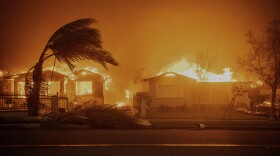The National Suicide Prevention Lifeline is a hotline for individuals in crisis or for those looking to help someone else. To speak with a certified listener, call 988.
CrisisText Line is a texting service for emotional crisis support. To speak with a trained listener, text HELLO to 741741. It is free, available 24/7, and confidential.
At Cornerstone Equine Therapy Center outside San Diego, Judy Beckett has been working with the Navy for more than a decade. These days, most of her calls are from Navy commanders searching for new ideas to increase resiliency among sailors.
She said horses have almost a meditative power with sailors working through PTSD or military sexual trauma.
“There's an intangible that nobody really knows why, but when you're with them, you literally don't think of anything else. And you can't,” she said.
A former client called her a year after he completed therapy. He told her that he considered killing himself. When she asked him what stopped him, he told her he thought about the horse he rode during the program.
“He said that dude has saved my life so many times,” Beckett said. “And he said, 'Judy, I just thought about him and how good I felt and how he changed my life.' And he goes, 'It just stopped me. It stopped me.'"
More than 500 military personnel die by suicide each year, though the number dropped slightly last year. This summer a Pentagon Committee visited bases around the world including Nellis Air Force Base in Nevada, Fort Campbell in Kentucky, Naval Air Station North Island in California, Camp Lejeune in North Carolina, the North Carolina National Guard, and Camp Humphreys in South Korea. The panel also visited three bases in Alaska, where there have been several suicides.
Despite the scrutiny, another four suicides took place in November at the Navy’s Regional Maintenance Center in Norfolk, Virginia. Earlier in the year, in nearby Newport News, seven suicides were reported on the USS George Washington.
After visiting the ship, Master Chief Russell Smith told Congress in May that he once struggled with suicidal thoughts. He also recounted a story of a colleague - a Navy SEAL - who died by suicide.
“Suicide is a massive problem for us, because it’s the one thing we can prevent absolutely by getting inside people’s headspace and connecting to them,” Smith said.
“A person who dies by suicide could look like your neighbor,” said Jenny D’Olympia, Director of Military Veteran Psychology at William James College in Massachusetts. “They could be the person next door. It doesn't have to be somebody who seems to be losing their mind and is in constant crisis.”
D’Olympia said the services should prepare everyone to better handle dark moments. Because guns are used in a majority of military suicides. D'Olympia said the armed forces should give all troops strategies for safe handling of personal firearms, and not focus just on people having mental health crises.
“I think what we have to do is focus our efforts on the other people,” she said. “Like preparing them to be aware that you could have this fleeting thought and because you have easy access to a highly lethal means, you could take action that you can't take back.”

Teri Caserta’s son Brandon killed himself four years ago, by walking into a helicopter blade at his base in Norfolk. After Brandon’s death, his parents found six suicide notes where he detailed bullying and hazing at his command.
“We were looking through his phone, and we noticed he was texting a lot of people in his command and talking them out of dying by suicide," she said.
She and her husband Pat lobbied to pass federal legislation that took effect this year, which requires mental health evaluations for those who report suicidal thoughts. It also allows sailors and soldiers to go outside their chain of command for mental health care. The rules are similar to those put into place to protect victims of sexual assault.
Caserta said the services need to do more to protect junior sailors before they struggle.
“In my opinion, this panel that they’re putting together, and now this report that they’re putting together, it’s not going to be accurate,” she said. “They’re not looking at the real issue. The real issue is toxic leadership and abuse of power.”
The panel is scheduled to report to Secretary of Defense Lloyd Austin in December, then send a report to Congress by February.
This story was produced by the American Homefront Project, a public media collaboration that reports on American military life and veterans.Funding comes from the Corporation for Public Broadcasting.
Copyright 2022 North Carolina Public Radio – WUNC. To see more, visit .







